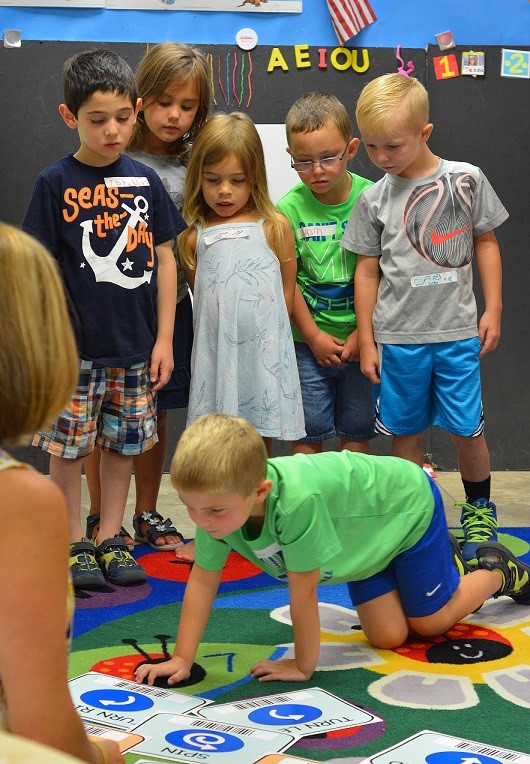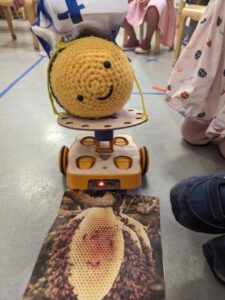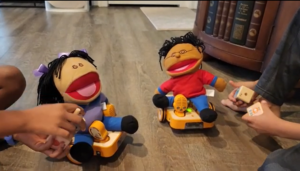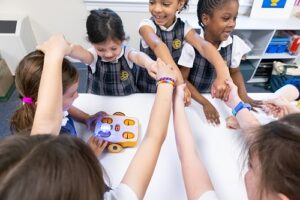KIBO Engineering in a Summer STEM Program
Contributed by: Nancy Kincaid, Preschool Teacher, Suncrest Primary School, Morgantown, WV, http://ses.mono.k12.wv.us/

I used KIBO and it’s Engineering Design Journals in a four-day STEM summer program for Pre-K kids this summer. I wanted to focus on Simple Machines and include the KIBO robot which has wheels. I decided to focus on “Force” my first day. We swung a beach ball pendulum and talked about how things need force in order to move. We explored friction by pushing a brick on the rug with nothing under it, then placing some pencils under it and pushing it over the pencils. The children noted how much easier the brick moved with the pencils underneath.
We broke into groups and my helpers did activities with different simple machines such as inclined planes and marbles (marble mazes), horizontal and vertical pulleys (carrying a load over a paper river, and using a wand magnet on a vertical pulley to pick up metal objects), using different weights of pendulums to “bowl” over different sized and weighted bottles, and my station, which was learning about how the KIBO robot moves. We learned the robot parts song and learned that the batteries provide the force necessary to make the robot move. I gave each child (4 or 5 in each group) his own robot and a few blocks. I told them that the ‘begin’ block means ‘go’ and is like using a capital letter at the beginning of a sentence and the ‘end’ block means ‘stop’ and is like using a period. After telling them they always needed a begin and end block, I let them arrange the movement blocks any way they desired. I then helped them scan their programs. I also introduced the “output” sensors during this first session.
Using the individual journals, I had them make a plan for what they would like to turn their robot into – a vehicle, and animal, or a person. I had recycled materials available for them to make one of those things. I also prepped some cardboard circles and rectangles so the children could build their creation on the cardboard and clip it onto the rotating or stationary platforms.
On Day Two, right when the children came in, I had set up the craft materials on the tables. The children who had planned to make people had materials such as paper towel tubes, styrofoam balls, yarn, google eyes, pompoms, paint, and construction paper. My three helpers and I helped each child complete what they wanted to make, taping them onto the cardboard platforms I had cut. We had 17 pre-k kids making their creations at one time!

After each child had gotten a good start on their creation, I put them aside and we went to Circle. At Circle we sang the robot parts song and the Engineering Design Process song (to Twinkle Twinkle). When we broke into groups, each of the previous day’s groups used the simple machines to make something to take home. The ‘inclined planes’ group made marble mazes on large cardboard pieces using masking tape and towel rolls. The ‘pendulum’ group used cone pendulums filled with paint and made paintings by swinging the different colored paint pendulums different ways over a poster board sheet. The ‘pulley’ group used a shoe box and a straw and some string with a paper egg carton bucket to make a vertical pulley to lift a load of pompoms.
The KIBO group with me learned how to use the ‘input’ sensor – the ear. I showed the children how to program the ‘wait for clap’ command in. We worked on learning to become master ‘scanners’ and ‘programmers’ and I stamped each child’s checklist as they accomplished a different level in programming.
Beginning from the first day, I had spread a very large cardboard sheet out on the floor for us to work with the robots on. The plan was to invite the children to create a road on which their robots would drive. The children used construction paper an glued it down using glue pots with paint brushes. Each group took turns adding to it. They used unit blocks to build houses, playground equipment, and added toy people to the scene.
Day Three, when the children came in, they finished up making their creations so we could concentrate on developing their final program for day four when their parents would come to watch. At Circle we sang the two songs again and also sang the KIBO pokey song, performing it. I used the command cards and let each child add a command, then we all performed the program. I used the blocks and showed them how to program the robot to do the KIBO Hokey Pokey. All the groups continued rotating through the different activities, and played with K’nex, Magformers, Wooden marble toys, and legos during down time. I might add that I had purchased several books on force, friction, inclined planes, pulleys, etc. and read one each day.
My KIBO groups worked on programming and scanning and learned to use “repeat/end repeat” blocks. My assistant had finished pendulum painting with all the kids, so I had her help each child complete pages in their Journal – she took dictation about what their creation was, and I had copied extra pages with the programming icons, cutting them and placing them on trays for the children to pick up and glue in their journal to show the program they wrote. She helped them do this and also they also told her which sensors and attachments they had used. We didn’t have time to revise programs in the journal or finish all of the pages but I thought they could work on the ‘quiz’ at home with parents.
Day Four, we continued singing the songs and discussing force and friction. Each day we had gone outside and used a couple of very large sheets of cardboard to make a slide on the grass hill. We had races – sitting on our shorts, sitting on a piece of cardboard, and sitting on a piece of waxed paper. The children concluded that the waxed paper was fastest because there was less friction. I wanted to get into the wheel and axle, making little milk bottle cars with a straw axle and milk cap wheels, but we just ran out of time.
While children chose different STEM activities, one of my helpers made catapults with them out of old markers, tongue depressors, plastic spoons, and rubber bands. They made a target and shot pompoms at it.
My assistant continued helping children finish in their journals, while I let the kids work on decorating the stage for their robot performances. When it came time for the parents, each child used two bull-nosed clips to clip their cardboard platform onto the wooden platform. They demonstrated making the block sentence, then scanning it and making KIBO move.
Some of the children mastered scanning by themselves. I was really impressed! Especially since we had only 4 mornings to work on programming! All of the parents were so impressed, and daily children were heard on more than one occasion saying, “This is the best camp I’ve ever been to!!!” I had lots of great comments from parents, too.





















